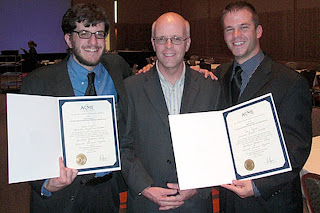Students take top prize for innovative new process for manufacturing advanced composites
Troy, N.Y. – For the second year in a row, a pair of Rensselaer students took first place at the annual Student Manufacturing Design Competition held by the American Society of Mechanical Engineers (ASME).
Mechanical engineering doctoral students Casey Hoffman and Jaron Kuppers won top honors in the national competition last month for their innovative Specialized Elastomeric Tooling (SET) process. The SET process offers a new method for curing advanced composites, which are highly customizable materials frequently used in a range of critically important applications from aircraft to windmill blades to biomedical devices. The new process is significantly less expensive and requires 500 to 1,000 times less energy than the conventional curing method used around the globe.
The competition, held in mid-October at the 2010 ASME International Manufacturing Science and Engineering Conference in Erie, Penn., was established in 1995 and is among the leading national manufacturing and design competitions for undergraduate and graduate students. Hoffman and Kuppers presented at the event, and were accompanied by faculty project sponsor Daniel Walczyk, associate professor in the Department of Mechanical, Aerospace, and Nuclear Engineering (MANE) at Rensselaer.
Despite their strength and versatility, the potential of advanced composites is limited because the materials are difficult and expensive to produce. The patent-pending SET process put forth by Hoffman and Kuppers replaces the need for autoclaves – energy-intensive machines that cost hundreds of thousands of dollars – in composites manufacturing.
The SET process holds the potential to trim the manufacturing cost of advanced composites, and widen the playing field of businesses that can afford to research and manufacture these materials. The process involves curing a composite laminate by pressing the material between heated, rubber-lined molds. Heating occurs quickly because the composite is in direct contact with the tool. The shape of the rubber mold half is derived computationally using 3-D computer modeling and simulations.
Overall, the SET process results in up to a 1,000-fold energy savings over an autoclave and eliminates the need for expensive consumable materials that are sent to a landfill after each use. The time required to prepare a composite part for curing in an autoclave is a few hours, while it takes less than 10 minutes to perform the prep on a SET system. The award-winning student innovation adds intellectual value to the age-old manufacturing method, while keeping the process simple enough for implementation in industry. The research is sponsored by Kintz Plastics Inc. in Howes Cave, N.Y., and the New York State Energy Research and Development Authority (NYSERDA).
"The ASME Student Manufacturing Design Competition is arguably the most prestigious U.S. competition for undergraduate and graduate students working on manufacturing research and development. The fact that Jaron and Casey placed first and two other student groups were finalists in this competition is evidence that Rensselaer runs a world-class manufacturing program," said Walczyk. "I believe that Rensselaer faculty and students will continue to play a leading role in demonstrating U.S. manufacturing excellence and helping prevent further erosion of manufacturing jobs, especially in the advanced composites arena."
At this year's ASME Student Manufacturing Design Competition, three of the nine finalists were from Rensselaer. Along with the team of Hoffman and Kuppers, Rensselaer mechanical engineering senior Kyle Mattson presented his manufacturing design, "Puckman Tape Dispenser," and mechanical engineering graduate student David Guglielmo presented his project, "Athletic Tape Cutter and Cleat Wrench."
In 2009, a team consisting of Rensselaer mechanical engineering doctoral students Christina Laskowski and Todd Snelson, along with mechanical engineering senior Saadia Safir, won first place at the Student Manufacturing Design Competition for their "Sustain-a-Pet" project. The winning entry was for a new design and process to make cute, fully recyclable teddy bears out of fleece sourced from recycled PET plastic and assembled using ultrasonic welding in place of thread and glue.
A year earlier, in 2008, a team of Rensselaer students took second place in the ASME Student Manufacturing Competition for their method to produce and assemble rocket-shaped candy dispensers. Additionally, in 2007 another Rensselaer team — on which Hoffman was a member—placed second for their method to produce small crystal replicas of the then-uncompleted Curtis R. Priem Experimental Media and Performing Arts Center (EMPAC).
Many of these projects resulted from assignments from the School of Engineering course Advanced Manufacturing Lab (AML). As part of the class, teams of students are given conceptual product designs from the Product Design and Innovation studio class at Rensselaer, and asked to devise the best way of manufacturing the item. The second part of the project is to employ this manufacturing method — everything from buying components and devising quality control oversight to producing, tooling, and programming robots — and demonstrate that it could work. ###
Contact: Michael Mullaney mullam@rpi.edu 518-276-6161 Rensselaer Polytechnic Institute















No comments:
Post a Comment